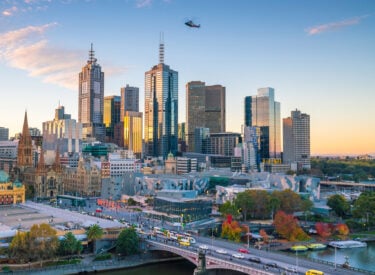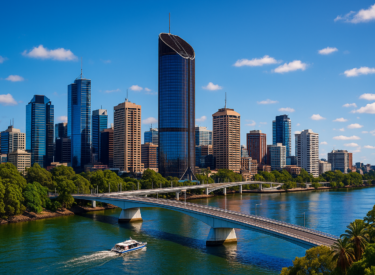
Key takeaways
In 2022, inflation became a problem as Australians joyfully embraced life after COVID-19 lockdowns, and supply issues were exacerbated by the war in Ukraine.
The Reserve Bank raised interest rates in May, the first rise in nearly 12 years, to 0.35 per cent.
Eight consecutive rate rises later, Australia's official cash rate now stands at 3.10 per cent, the fastest tightening cycle in more than 30 years.
The shock of interest rate rises was far more material than just sentiment. Potential buyers watched their borrowing capacity fall with each interest rate rise, and by the September quarter, house prices were falling in every capital city bar Adelaide.
The property market has not done a complete 180, because historically, property booms have been far more supersized than downturns. In other words, Australia's house prices tend to go up a lot more than they go down.
In 2023, the property market will adjust to its new normal, with some areas falling faster, while others will be more resilient. Entry-priced houses and units will hold firmer, particularly in the most expensive capital cities, Sydney and Melbourne.
A lot has happened to our property market over the last year, hasn't it?
For one, the property boom of 2020-21 ended.
Obviously, a property cycle is exactly that - a cycle.
While homeowners and property investors enjoyed the strength of the "once-in-a-generation" property boom (which will go down in history and long remembered), that pace of growth was not sustainable.
The boom that busted
Dr. Nicola Powell, chief of research and economics at Domain, explained it this way....
Across the nation, armed with record low interest rates and a manic-sized dose of Fear of Missing Out (FOMO), Australians fuelled price rises not seen since the likes of, well, ever.
The national median price for a house hit $1.066 million.
Sydney’s house prices rose by $1100 a day. Just to repeat: $1100 a day.
Smug sellers quickly became desperate buyers. Lots of records were broken and the skyrocketing prices were, depending on your circumstances, either something to be despaired, or a massive financial windfall.
But the saying “nothing lasts forever” was not coined from fiction.
Well, firstly, there was an affordability ceiling.
People got to a point where they simply cannot keep paying anymore.
In fact, Canberra and Melbourne started to show signs of this fatigue by the end of 2021 and data from Domain's End of Year Wrap 2022 showed that these housing markets actually peaked in December 2021.
On the other hand, other cities, like Sydney, Brisbane, Adelaide, Perth and Hobart, continued to get even more expensive, albeit at a slower rate, throughout 2022, with each market peaking at different points.
When each capital city market peaked
| Capital City | Price peak achieved |
| Sydney | Mar-22 |
| Melbourne | Dec-21 |
| Brisbane | Mar-22 |
| Adelaide | Sep-22 |
| Canberra | Dec-21 |
| Perth | Jun-22 |
| Hobart | Mar-22 |
| Darwin | Dec-13 |
Source: Domain House Price Report, Q3.
Inflation became a problem in 2022
Ellen Lutton writes in Domain...
Groceries, petrol, rent and childcare got more expensive very quickly.
There is a combination of factors, including the federal government’s stimulus packages like Home Builder, a surge in spending as Australians joyfully embraced life after COVID-19 lockdowns, and a hangover of supply issues that began during the pandemic, was exacerbated by the war in Ukraine, and by May, inflation had surged to a 20-year high.
Of course, the Reserve Bank pulled the only lever it has to reign in inflation, and interest rates went up.
The official cash rate was raised by 0.25 percentage points in May – the first rise in nearly 12 years – to 0.35 per cent.
The rate then kept going up.
The RBA moved aggressively, hoping to get on top of inflation quickly, and eight consecutive rate rises later, Australia’s official cash rate now stands at 3.10 per cent.
The fastest tightening cycle in more than 30 years
Today people borrow more now.
Not because they are more frivolous than previous generations but simply because property costs so much more, even for an entry-level home on the outskirts of a city, even for a home in our regional towns.
In fact, some of the biggest price rises in the entire nation during the pandemic boom occurred in regional locations.
There isn’t a region in Tasmania that hasn’t risen by at least 20 per cent in the past 12 months.
In the past five years, most prices have doubled.

Regional Victoria, NSW and south-east Queensland, particularly the Gold and Sunshine Coasts, have seen eye-watering price rises.
For example, for someone servicing a home loan principal of $750,000 – a figure well below the national median house price – their 2 per cent interest rate on a 30-year loan in April, at $2772 a month, has skyrocketed to a 5 per cent interest rate in December, costing $4026 a month.
Unsurprisingly, eight consecutive interest rate rises have taken their toll on Australia’s property market.
At first, it was a softening in our largest capital cities, then it spread geographically, and prices stalled in other capital cities and in regional areas.
Because of this, buyers started to hold back and sit on the fence, uncertain of how the market would unfold and also knowing that – for the first time in more than two years – they had the upper hand.
And the supply of property for sale increased.
Not because there was a rush of buyers needing to sell in a falling market but simply because property was no longer turning over at the high rates it had been only months earlier.
The shock of interest rate rises was far more material than just sentiment
With each interest rate rise – and the RBA handed down double hikes of 0.5 percentage points in June, July, August and September – potential buyers watched their borrowing capacity fall.

Shane Oliver, AMP Capital’s Chief Economist said:
“The problem for the property market is the amount of money a new borrower can raise to buy a house is substantially less than it was earlier this year.
In some cases borrowing power is 25 per cent less.”
This means that people cannot borrow as much, and they cannot pay as much.
Very quickly, prices softened, auction clearance rates weakened, and sellers lowered their prices.
By the September quarter, house prices were falling in every capital city bar Adelaide, where prices flattened.
Nationally, house prices have now fallen 4.9 per cent from the March 2022 price peak, down about $53,000.
It’s been a “roller coaster” of a year for property
Dr Nicola Powell explained:
“The past two years have been fascinating to watch in real estate.
After soaring price growth in 2021, it was inevitable that we would see an adjustment phase of the property cycle in 2022.
In 2022, the market saw a stark contrast with house prices across the combined capital cities switching to their fastest quarterly decline on record.
As this took place, the property market rapidly shifted to provide buyers greater negotiation power.
At the same time, affordability became an issue due to consecutive rate hikes and rising inflation creating weaker consumer confidence.”
But here’s where some perspective is important.
While it may feel like the property market has done a complete 180, in reality, it’s way off that.

You see, even after losing $53,000 from its price peak, the national median house price is still 27 per cent – about $218,000 – higher than it was before the pandemic boom.
For example, Adelaide is about 47 per cent higher – or about $253,732 more expensive – Canberra is still 41 per cent or $320,092 higher, and Sydney is 29 per cent higher, or $326,101 more expensive.
In fact, prices in every single capital city are still significantly higher now than they were before the pandemic boom began.
| City | Now compared to pandemic trough | Price difference |
| Sydney | 29% | $326,101 |
| Melbourne | 17% | $147,163 |
| Canberra | 41% | $320,092 |
| Brisbane | 36% | $215,160 |
| Adelaide | 47% | $253,732 |
| Perth | 22% | $116,123 |
Dr Powell further explains...
This is because, historically, property booms have been far more supersized than downturns.
In other words, Australia’s house prices tend to go up a lot more than they go down.
Domain analysed almost three decades of data and found out that Australia’s prices don’t actually go through wild boom and bust phases.
Instead, Australia tends to see a period of gains (quite often surging), followed by a slight decline or flatlined pricing.
The average upswing generally spans 2.75 years, with a 32.7 per cent price rise, from peak to trough, while on average, downturns experience a 3 per cent price decrease over 0.75 years (or just several months).

Dr Powell further explained:
"It’s important for buyers and sellers to keep this in mind, especially during times of uncertainty in a downturn, and to take a longer-term view.
It’s about maintaining an overall perspective … it’s not timing the market, it’s the time spent in the market that counts.
While property prices will continue to soften in 2023, it is unlikely they will erase all the growth seen during the pandemic boom.
Initially, rate hikes were a huge shock to potential buyers in 2022, but now buyers have adjusted to this new norm and are more mindful of their lower borrowing capacity.”
Australians are adjusting to the new economic environment
The latest Consumer Sentiment Report from Westpack confirms that Aussies are adjusting to this new economic landscape.
Bill Evans, Westpac's Chief Economist commented:
“We have seen a sharp improvement in the outlook for house prices; a lift in confidence amongst respondents with a mortgage; and a significant improvement in consumers’ outlook for their finances."
Agents say buyers and sellers have modified their expectations, and the market has now settled back into a more “normal” state rather than the frenzied state it was still in earlier last year.

A few weeks into 2023, Dr Powell says the "depth of this downturn will be largely shaped by how high-interest rates go, although rates are not the only factor influencing the property market."
She further said:
“Tax settings, banking regulation, population and income growth, and the responsiveness of new housing supply to growing demand all make an impact.
As the market continues to adjust to its new normal, new opportunities will emerge for buyers, particularly those looking to upgrade or buy in their dream neighbourhood.
I expect a multi-speed market will become more apparent in 2023 with some areas falling faster, while others will be more resilient.
Overall, entry-priced houses and units will hold firmer, particularly in the most expensive capital cities, Sydney and Melbourne.
This will be driven by the affordability barriers of purchasing, first-home incentives and deteriorating borrowing capacity steering demand to more affordable options.
This, coupled with the houses at the premium price point seeing greater falls, will create opportunities for upgraders.”
Source of charts, tables and commentaries: Domain














